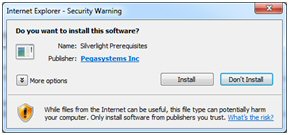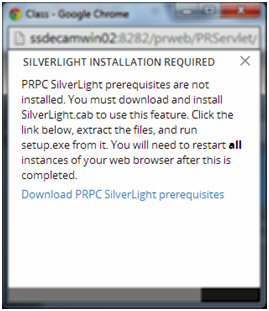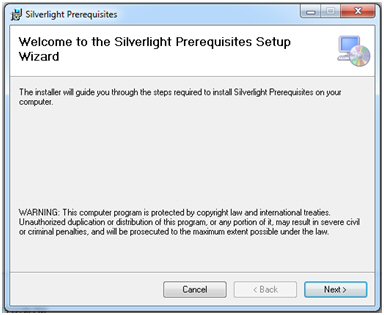Word merge support with Microsoft Silverlight plug-in
Valid from Pega Version 7.1.3
PRPC features that integrate with the Word merge capability are now cross-browser. ActiveX controls (which are only compatible with IE) have been replaced with Microsoft Silverlight. This plug-in must be downloaded separately from Microsoft, as it is not shipped with PRPC.
Some common PRPC features affected by this change include the Application Document Wizard, App Profile, Specifications Landing Page, Specification form, and Case Type Landing Page.
Prior to using these features, Users of PRPC 7.1.3 need to set up their client system(s) as follows:
1. Install Silverlight plug-in
Follow the PRPC prompt to install Silverlight when you attempt to use the Word merge feature:

Or download package directly: www.microsoft.com/silverlight/
2. Install PRPC prerequisites
Microsoft Internet Explorer (IE) browsers automatically detect the need for PRPC prerequisites and will prompt for install:

Non-IE browsers will load a pop-up window when the user attempts to use the Word merge feature. Use the link to manually download PRPC prerequisites:

Extract the .zip file, execute setup.exe and follow the install wizard:

Administrators setting up multiple clients at once may refer to the pzSLpreReqs.cab available in the PRPC 7.1.3 resource kit.
3. Restart browser
Log out of PRPC, close all open sessions and restart your browser.
The PRPC feature integrated with Word merge is now ready for use; Silverlight prompts are no longer displayed.
4. Troubleshooting
Silverlight installation requires access to your file system and a registry setting update to “trust” the associated Verisign certificate. Contact your administrator if you encounter any security or permission errors during this process.
See the PRPC Developer Help for more information on browser setup requirements.
Data Management
Valid from Pega Version 7.1.3
Improvements to data handling were made for the Data Pages, autopopulate properties, and reference properties. Lightweight lists were optimized.
- Property references are now maintained on the Work Page.
- PageList properties can reference a Data Page.
- Auto-populate properties can be used in a seciton to show results from a Data Page.
- Data Pages can run in “Page” mode as well as “List” mode
- The "Rules Not Using Lightweight List" report was enhanced.
- A PageList property that references a Data Page may be used to populate a grid.
- Related autopopulated properties can now be referenced.
Integration
Valid from Pega Version 7.1.3
Usability enhancements have been made to the integration wizards. The REST end-point integration has been improved, and XML parsing functionality has been enhanced.
- PRPC services can return Report or Listview data as XML.
- Work items may now be processed when accessing from a link in system-created emails.
- An SMTP outage will not cause an application to stop working.
- File listener will now read files using a leading asterisk (*).
- XML Parse rule will handle schema validation.
- PegaImageViewer will now work with Version 7.1.
- Security measures are enhanced for SOAP connections to web services.
- After generating rules using REST wizard, the Undo Generation button will delete all the generated rules.
- Email wizard has been improved.
Data page unit test case setup and cleanup
Valid from Pega Version 7.2.1
You can now use one or more data pages, data transforms, or activities to set up a clipboard page with the appropriate properties before you run a data page unit test case. You can also use activities to create any required test data, such as work or data objects.
After you run a data page unit test case, the data pages that were used to set up the test environment are automatically removed. You can now also apply additional data transforms or activities to clean up the clipboard.
For more information, see Setup and cleanup of data page unit test cases.
New assertions for data page unit test cases
Valid from Pega Version 7.2.1
You can now configure the following assertions for data page unit test cases:
- Result count assertions for page lists, page groups, value lists, and value groups
- Unordered list and ordered list assertions for page lists
The Pega 7 Platform now supports these assertions in addition to expected run-time assertions for the data page and property assertions for any property type.
For more information, see Data page unit test case assertions.
Execute Tests service to run all data page unit test cases
Valid from Pega Version 7.2.1
You can now use the Execute Tests service to run a set of tests at the end of build runs. An external validation engine, such as Jenkins, calls the service, which runs all data page unit test cases in your application, and returns the results in XUnit format. Use this service to validate the data in your application and to correct any issues before you deploy your application.
For more information, see Running all data page unit test cases with the Execute Tests service.
Quick and customized data imports
Valid from Pega Version 7.2.1
You can now quickly add, update, or delete data records for your data types by uploading .csv files that contain a large number of records. The bulk import process allows you to import data from a variety of sources and gives you more control over your data. You can customize this process by overriding a data transform to add purposes, a section to add fields, and an activity to define the logic for each purpose.
For more information, see Data import customization.
Enhancements to the REST integration wizard
Valid from Pega Version 7.2.1
You can use the improved REST integration wizard to quickly create data sources in your application. The steps in the wizard are now arranged in a manner that makes the process of creating REST integration more intuitive. You can add custom headers that allow you to connect to complex REST services. You can also enter the name of the system that hosts the REST service, which allows you to group data sources that connect to the same system.
For more information, see the REST integration section in Integration wizards.
Improved security for clipboard pages
Valid from Pega Version 7.2.1
To prevent data leakage and inconsistency, the Pega 7 Platform does not allow properties on a clipboard page to refer to properties on pages with a lower scope. For example, an autopopulate property on a node type clipboard page cannot source data from a data page with scope “requestor” or “thread.”
For more information, see Page scope types for data and declare pages.
Store and source content in Box
Valid from Pega Version 7.2.1
You can now attach content from Box while working on a case in your application. You can attach files directly to your case or include them in a Pulse message. You can also store all the case and Pulse attachments in your application in Box. To enable content sourcing and storage in Box, configure the Content sourcing and Content storage sections on the Integration & security tab of your application rule.
For more information, see Storing and sourcing content in Box.

